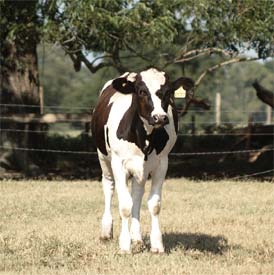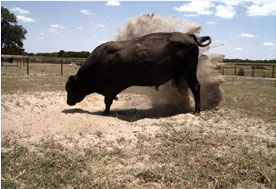The loss of productive function as a result of disease or injury in livestock presents at least two options: slaughter or euthanasia. Generally speaking, slaughter should be considered for animals that are not in severe pain, freely able to stand and walk, capable of being transported, and without disease or treatment that might constitute a public health risk (drug residue). Euthanasia is the appropriate choice whenever the above conditions cannot be met.

When conditions warrant euthanasia, the next consideration is method. There are essentially 2 methods for humane euthanasia in circumstances where veterinary supervision is unavailable:
- Gunshot with the appropriate caliber of firearm and a solid point bullet delivered to the correct anatomical site
- Penetrating captive bolt to induce immediate loss of consciousness followed by one or more of the following procedures to ensure death including:
- Exsanguination which causes death through blood loss
- Use of a pithing device (through the projectile entry site) to increase destruction of brain and spinal cord tissue
- The intravenous injection of approximately 120 ml. of potassium chloride (KCl) which results in cardiac arrest
Choices of one over the other should include concerns for human safety, animal welfare, ability to restrain the animal for proper application of the procedure, skill of the person performing the procedure, cost, rendering and carcass disposal considerations, and possibly, potential need for brain tissue (for diagnostic purposes) in the event that the animal is suspected of having rabies.
Persons conducting euthanasia procedures should attempt to minimize animal distress. If animals are accustomed to human contact the presence of a familiar person may be reassuring and reduce anxiety. On the other hand, for wildlife and animals unaccustomed to human contact, gunshot should be delivered with the least amount of human contact necessary. If the animal to be euthanized is ambulatory and able to be moved without causing distress, discomfort or pain, it may be moved to an area where the carcass may be more easily reached by removal equipment. Dragging of nonambulatory animals is unacceptable. In cases where movement may increase distress or animal suffering, the animal should be euthanized first, and moved following confirmation of death.
Special Considerations for Euthanasia of Bulls
Bulls present particular challenges because of size, attitude, and the physical thickness of their skull. Specialized heavy-duty penetrating captive bolt guns, higher caliber firearms or heavier gauge shotguns are required for euthanasia of bulls. As described previously, safety is of paramount importance. Since ideal positioning of either device requires close contact with the animal, restraint is usually necessary. Operators should recognize that restraint alone causes significant distress. By preparing the euthanasia device for use prior to restraining the animal, one can limit the restraint-related stress period.

Personnel Considerations
A final consideration is for the person who must perform the task of humane euthanasia. It is important to recognize that this is not a procedure that all persons are mentally or emotionally able to perform. This is particularly true if a person is in a position where they must perform these procedures repetitively. In fact, observation has shown that constant exposure to, or participation in, euthanasia procedures may result in psychological damage leading to work-related dissatisfaction and a tendency toward careless or callous handling of animals. One strategy for managing this problem includes providing adequate training so that euthanasia procedures may be competently applied. Another may be to change work duties as needed to provide relief when it becomes apparent that such duties are causing emotional distress. Euthanasia, regardless of the circumstances, impacts a person’s emotional state. Sensitivity to this issue should not be overlooked.
